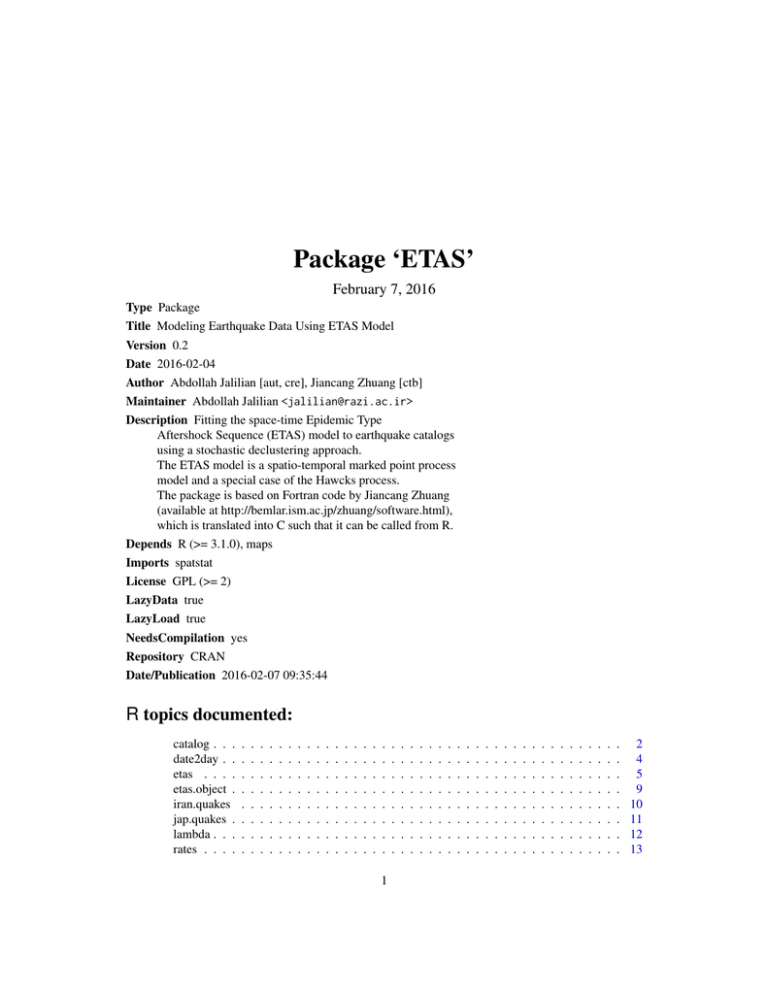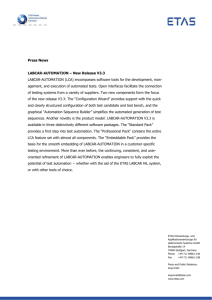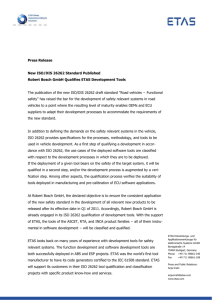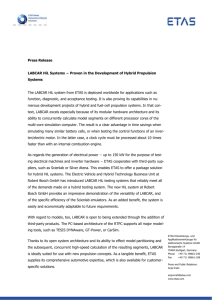Package `ETAS`
advertisement

Package ‘ETAS’
February 7, 2016
Type Package
Title Modeling Earthquake Data Using ETAS Model
Version 0.2
Date 2016-02-04
Author Abdollah Jalilian [aut, cre], Jiancang Zhuang [ctb]
Maintainer Abdollah Jalilian <jalilian@razi.ac.ir>
Description Fitting the space-time Epidemic Type
Aftershock Sequence (ETAS) model to earthquake catalogs
using a stochastic declustering approach.
The ETAS model is a spatio-temporal marked point process
model and a special case of the Hawcks process.
The package is based on Fortran code by Jiancang Zhuang
(available at http://bemlar.ism.ac.jp/zhuang/software.html),
which is translated into C such that it can be called from R.
Depends R (>= 3.1.0), maps
Imports spatstat
License GPL (>= 2)
LazyData true
LazyLoad true
NeedsCompilation yes
Repository CRAN
Date/Publication 2016-02-07 09:35:44
R topics documented:
catalog . . .
date2day . .
etas . . . .
etas.object .
iran.quakes
jap.quakes .
lambda . . .
rates . . . .
.
.
.
.
.
.
.
.
.
.
.
.
.
.
.
.
.
.
.
.
.
.
.
.
.
.
.
.
.
.
.
.
.
.
.
.
.
.
.
.
.
.
.
.
.
.
.
.
.
.
.
.
.
.
.
.
.
.
.
.
.
.
.
.
.
.
.
.
.
.
.
.
.
.
.
.
.
.
.
.
.
.
.
.
.
.
.
.
.
.
.
.
.
.
.
.
.
.
.
.
.
.
.
.
.
.
.
.
.
.
.
.
.
.
.
.
.
.
.
.
.
.
.
.
.
.
.
.
1
.
.
.
.
.
.
.
.
.
.
.
.
.
.
.
.
.
.
.
.
.
.
.
.
.
.
.
.
.
.
.
.
.
.
.
.
.
.
.
.
.
.
.
.
.
.
.
.
.
.
.
.
.
.
.
.
.
.
.
.
.
.
.
.
.
.
.
.
.
.
.
.
.
.
.
.
.
.
.
.
.
.
.
.
.
.
.
.
.
.
.
.
.
.
.
.
.
.
.
.
.
.
.
.
.
.
.
.
.
.
.
.
.
.
.
.
.
.
.
.
.
.
.
.
.
.
.
.
.
.
.
.
.
.
.
.
.
.
.
.
.
.
.
.
.
.
.
.
.
.
.
.
.
.
.
.
.
.
.
.
.
.
.
.
.
.
.
.
.
.
.
.
.
.
.
.
.
.
.
.
.
.
.
.
.
.
.
.
.
.
.
.
.
.
.
.
.
.
.
.
2
4
5
9
10
11
12
13
2
catalog
Index
16
catalog
Create an Earthquake Catalog
Description
Creates an object of class "catalog" representing an earthquake catalog dataset. An earthquake
catalog is a chronologically ordered list of time, epicenter and magnitude of all recorded earthquakes
in geographical region during a specific time period.
Usage
catalog(data, time.begin=NULL, study.start=NULL,
study.end=NULL, study.length=NULL,
lat.range=NULL, long.range=NULL,
region.poly=NULL, mag.threshold=NULL,
flatmap=TRUE, tz="GMT")
Arguments
data
A data.frame contaning date, time, latitude, longitude and magnitude of earthquakes.
time.begin
The beginning of time span of the catalog. A character string or an object that
can be converted to date-time (calendar dates plus time to the nearest second)
by as.POSIXlt. The default NULL sets it to the date-time of the first event.
study.start
The start of the study period. A character string or an object that can be converted to date-time by as.POSIXlt. If not specified (NULL), then time.begin is
used.
study.end
The end of the study period. A character string or an object that can be converted
to date-time by as.POSIXlt. The default NULL sets it to the date-time of the last
event.
study.length
A single numeric value specifying the length of the study period in decimal
days. Incompatible with study.end: either study.end or study.length can
be specified, but not both.
lat.range
The latitude range of a rectangular study region. A numeric vector of size 2
giving (latmin, latmax). By default (NULL) the range of the latitudes of events is
used.
long.range
The longitude range of a rectangular study region. A numeric vector of size 2
giving (longmin, longmax). By default (NULL) the range of the longitudes of
events is used.
region.poly
Polygonal boundary of a non-rectangular study region. A list with components
lat and long of equal length specifying the coordinates of the vertices of a polygonal study region. The vertices must be listed in anticlockwise order.
mag.threshold
The magnitude threshold of the catalog. A positive numeric value. The default
(NULL) sets it to the minimum magnitude of all events.
catalog
3
flatmap
Logical flag indicating whether to adjust the longitudes of events and the study
region in order to have a flat map coordinates.
tz
A character string specifying the time zone to be used for the date-time conversion in as.POSIXlt. The default "GMT" is the UTC (Universal Time, Coordinated).
Details
The data is required to have at least 5 columns with names date, time, lat, long and mag containing, respectively, the date, time, latitude, longitude and magnitude of each event in the catalog.
The geographical study region can be rectangular or polygonal:
• rectangular study region can be specified by lat.range and long.range which must be
numeric vectors of length 2.
• polygonal study region can be specified by region.poly which containst coordinates of the
vertices of the polygon. It must be eighter a list with components lat and long of equal length
or a data.frame with columns lat and long. The vertices must be listed in anticlockwise order
and no vertex should be repeated (i.e. do not repeat the first vertex).
The function inside.owin in the spatstat is used to indicate whether events lie inside the study
region. Only events inside the study region and the study period (study.start, study.end) are
considered as target events. Other events are assumed to be complementary events.
If the events in data are not chronologically sorted, then a warning will be produced and the events
will be sorted in ascending order with respect to time of occurrence.
If flatmap=TRUE, longitude-latitude coordinates convert to flat map coordinates. The algorithm
does not change the latitude of points but adjust the longitude of points with respect to the centroid
of the target geographical region in order to get coordinates on a flat surface.
Value
An object of class "catalog" containing an earthquake catalog dataset.
Author(s)
Abdollah Jalilian <jalilian@razi.ac.ir>
References
Zhuang, J. (2012). Long-term earthquake forecasts based on the epidemic-type aftershock sequence
(ETAS) model for short-term clustering. Research in Geophysics, 2(1), 8.
See Also
etas.
4
date2day
Examples
data(iran.quakes)
summary(iran.quakes)
# creating a catalog with rectangular study region
iran.cat <- catalog(iran.quakes, time.begin="1973/01/01",
study.start="1985/01/01", study.end="2016/01/01",
lat.range=c(25, 42), long.range=c(42, 63), mag.threshold=4.5)
print(iran.cat)
## Not run:
plot(iran.cat)
## End(Not run)
# equivalently, specifying the length of the study period
iran.cat2 <- catalog(iran.quakes, time.begin="1973/01/01",
study.start="1985/01/01", study.length=11322,
lat.range=c(25, 42), long.range=c(42, 63), mag.threshold=4.5)
print(iran.cat2)
data(jap.quakes)
summary(jap.quakes)
# specifying a polygonal geographical region
jpoly <- list(long=c(134.0, 137.9, 143.1, 144.9, 147.8,
137.8, 137.4, 135.1, 130.6), lat=c(31.9, 33.0, 33.2,
35.2, 41.3, 44.2, 40.2, 38.0, 35.4))
# creating a catalog with polygonal study region
jap.cat <- catalog(jap.quakes, time.begin="1966-01-01",
study.start="1970-01-01", study.end="2010-01-01",
region.poly=jpoly, mag.threshold=4.5)
print(jap.cat)
## Not run:
plot(jap.cat)
## End(Not run)
date2day
Convert date-time data to numeric data in decimal days
Description
A function to convert date-time data to decimal days with respect to a date-time origin.
etas
5
Usage
date2day(dates, start=NULL, tz="", ...)
Arguments
dates
A date-time or date object. Typically, it is a character vector containing datetime information.
start
A date-time or date object. Determines the origin of the conversion.
tz
Optional. Timezone specification to be used for the conversion.
...
Arguments to be passed to as.POSIXlt.
Details
The arguments dates and start must be of appropriate format to be passed to as.POSIXlt function.
Value
A numeric vector of the same length as dates.
Author(s)
Abdollah Jalilian <jalilian@razi.ac.ir>
See Also
as.POSIXlt and difftime for appropriate format of the data to be converted.
Examples
# date-time data of Iran's earthquakes between 1973/01/01 and 2016/01/01
dt <- paste(iran.quakes$date, iran.quakes$time)
# origin of the conversion
start <- "1973/01/01 00:00:00"
# time in days since 1973-01-01 (UTC)
date2day(dt, start, tz="GMT")
etas
Fit the space-time ETAS model to data
Description
A function to fit the space-time version of the Epidemic Type Aftershock Sequence (ETAS) model
to a catalog of earthquakes (a spatio-temporal point pattern) and perform a stochastic declustering
method.
6
etas
Usage
etas(object, param0, bwd = NULL, nnp = 5, bwm = 0.05,
verbose = TRUE, plot.it = FALSE, no.itr = 11)
Arguments
object
An object of class "catalog" containing an earthquake catalog dataset.
param0
Initial guess for model parameters. A numeric vector of appropriate length (currently 8). See details.
bwd
Optional. Bandwidths for smoothness and integration on the geographical region win. A numeric vector which has the length of the number of events. If not
supplied, the following arguments nnp and bwm determine bandwidths.
nnp
Number of nearest neighbors for bandwidth calculations. An integer.
bwm
Minimum bandwidth. A positive numeric value.
verbose
Logical flag indicating whether to print progress reports.
plot.it
Logical flag indicating whether plot probabilities of each event being a background event on a map.
no.itr
An integer indicating the number of iterations for convergence of the iterative
approach of declustering algorithm. See details.
Details
Ogata (1988) introduced the epidemic type aftershock sequence (ETAS) model based on GutenbergRichter law and modified Omori law. In its space-time representation (Ogata, 1998), the ETAS
model is a temporal marked point process model, and a special case of marked Hawks process, with
conditional intensity function
X
λ(t, x, y|Ht ) = µ(x, y) +
k(mi )g(t − ti )f (x − xi , y − yi |mi )
ti <t
where
Ht : is the observational history up to time t, but not including t; that is
Ht = {(ti , xi , yi , mi ) : ti < t}
µ(x, y): is the background intensity. Currently it is assumed to take the semi-parametric form
µ(x, y) = µu(x, y)
where µ is an unknown constant and u(x, y) is an unknown function.
k(m): is the expected number of events triggered from an event of magnitude m given by
k(m) = A exp(α(m − m0 ))
g(t): is the p.d.f of the occurrence times of the triggered events, taking the form
g(t) =
p−1
t
(1 + )−p
c
c
etas
7
f (x, y|m): is the p.d.f of the locations of the triggered events, considered to be either the long tail
inverse power density
q−1
x2 + y 2 −q
f (x, y|m) =
(1 +
)
πσ(m))
σ(m)
or the light tail Gaussian density (currently not implemented)
f (x, y|m) =
x2 + y 2
1
exp(−
)
2πσ(m)
2σ(m)
with
σ(m) = D exp(γ(m − m0 ))
The ETAS models classify seismicity into two components, background seismicity µ(x, y) and
clustering seismicity λ(t, x, y|Ht ) − µ(x, y), where each earthquake event, whether it is a background event or generated by another event, produces its own offspring according to the branching
rules controlled by k(m), g(m) and f (x, y|m).
Background seismicity rate u(x, y) and the model parameters
θ = (µ, A, c, α, p, D, q, γ)
are estimated simultaneously using an iterative approach proposed in Zhuang et al. (2002). First, for
an initial u0 (x, y), the parameter vector θ is estimated by maximizing the log-likelihood function
Z
X
l(θ) =
λ(ti , xi , yi |Hti ) − λ(t, x, y|Ht )dxdydt.
i
Then the procedure calculates the probability of being a background event for each event in the
catalog by
µ(xi , yi )
φi =
.
λ(ti , xi , yi |Hti )
Using these probabilities and kernel smoothing method with Gaussian kernel and appropriate choice
of bandwidth (determined by bwd or nnp and bwm arguments), the background rate u0 (x, y) is updated. These steps are repeated enough times (determined by no.itr argument) such that the results
converge.
This version of the ETAS model assumes that the earthquake catalog is complete and the data are
stationary in time. If the catalog is incomplete or there is instationarity (e.g. increasing trend) in the
time of events, then the results of this function are not reliable.
Value
A list with components
param: The ML estimates of model parameters.
bk: An estimate of the u(x, y).
pb: The probabilities of being background event.
opt: The results of optimization: the value of the log-likelihood function at the optimum point, its
gradient at the optimum point and AIC of the model.
rates: Pixel images of the estimated total intensity, background intensity, clustering intensity and
conditional intensity.
8
etas
Note
This function is based on a C port of the original Fortran code by Jiancang Zhuang, Yosihiko
Ogata and their colleagues. The etas function is intended to be used for small and medium-size
earthquake catalogs. For large earthquake catalogs, due to time-consuming computations, it is
highly recommended to use the parallel Fortran code on a server machine. The Fortran code
(implemented for parallel/non-parallel computing) can be obtained from http://bemlar.ism.ac.
jp/zhuang/software.html.
Author(s)
Abdollah Jalilian <jalilian@razi.ac.ir>
References
Zhuang, J., Ogata, Y. and Vere-Jones, D. (2005). Diagnostic analysis of space-time branching
processes for earthquakes. Lecture Note in Statistics: Case Studies in Spatial Point Process Models
(Baddeley, A., Gregori, P., Mateu, J., Stoica, R. and Stoyan, D.), Springer-Verlag, New York, 185,
276–292.
Zhuang, J., Ogata, Y. and Vere-Jones, D. (2002). Stochastic declustering of space-time earthquake
occurrences. Journal of the American Statistical Association, 97, 369–380.
Ogata, Y. (1998). Space-time point-process models for earthquake occurrences. Annals of the
Institute of Statistical Mathematics, 50, 379–402.
Ogata, Y. (1988). Statistical models for earthquake occurrences and residual analysis for point
processes. Journal of American Statistical Association, 83, 9–27.
See Also
catalog for constructing data.
Examples
# fitting the ETAS model to an Iranian catalog
summary(iran.quakes)
# preparing the catalog
iran.cat <- catalog(iran.quakes, time.begin="1973/01/01",
study.start="1996/01/01", study.end="2016/01/01",
lat.range=c(25, 42), long.range=c(42, 63), mag.threshold=4.5)
print(iran.cat)
## Not run:
plot(iran.cat)
## End(Not run)
# initial parameters values
param01 <- c(0.46, 0.23, 0.022, 2.8, 1.12, 0.012, 2.4, 0.35)
# fitting the model
etas.object
9
## Not run:
iran.fit <- etas(iran.cat, param0=param01, no.itr=5)
## End(Not run)
# fitting the ETAS model to a Japanese catalog
# preparing the catalog
jpoly <- list(long=c(134.0, 137.9, 143.1, 144.9, 147.8,
137.8, 137.4, 135.1, 130.6), lat=c(31.9, 33.0, 33.2,
35.2, 41.3, 44.2, 40.2, 38.0, 35.4))
jap.cat <- catalog(jap.quakes, time.begin="1966-01-01",
study.start="1970-01-01", study.end="2010-01-01",
region.poly=jpoly, mag.threshold=4.5)
## Not run:
plot(jap.cat)
## End(Not run)
# initial parameters values
param00 <- c(0.6, 0.2, 0.02, 1.5, 1.1, 0.0012, 1.8, 1.0)
# fitting the model
## Not run:
jap.fit <- etas(jap.cat, param0=param00)
## End(Not run)
etas.object
Class of Fitted ETAS Models
Description
A class etas to represent a fitted ETAS model. The output of etas.
Details
An object of class etas represents an ETAS model that has been fitted to a spatio-temporal point
pattern (catalog) of earthquakes. It is the output of the model fitter, etas.
The class etas has methods for the following standard generic functions:
generic
print
method
print.etas
Author(s)
Abdollah Jalilian <jalilian@razi.ac.ir>
description
print details
10
iran.quakes
See Also
etas,
Examples
# fitting the ETAS model to an Iranian catalog
data(iran.quakes)
summary(iran.quakes)
# preparing the catalog
iran.cat <- catalog(iran.quakes, time.begin="1973/01/01",
study.start="1985/01/01", study.end="2016/01/01",
lat.range=c(25, 42), long.range=c(42, 63), mag.threshold=4.5)
## Not run:
plot(ir.cat)
## End(Not run)
# initial parameters values
param01 <- c(0.4339678,
0.1988628,
0.0345206,
1.6290137,
1.1286776,
0.0072539,
2.1705884,
0.5706402)
# fitting the model
## Not run:
res <- etas(ir.cat, param0=param01, no.itr=5)
## End(Not run)
iran.quakes
An Iranian Earthquake Catalog
Description
A data frame with 5970 rows and 5 columns giving occurrence date, time, longitude, latitude and
magnitude of shallow earthquakes (depth < 100 km) occurred since 1973-01-01 till 2016-01-01 in
Iran and its vicinity (40-65E and 22-42N). Only earthquakes with magnitude greater than or equal
to 4.5 are included.
Usage
data(iran.quakes)
jap.quakes
11
Format
An object of class "data.frame" containing the following columns:
• date Occurrence date in the format "yyyy-mm-dd"
• time Occurrence time (UTC) in the format "hh:mm:ss"
• long Latitude of epicenter in decimal degrees
• lat Latitude of epicenter in decimal degrees
• mag Magnitude in body-wave magnitude scale (mb)
Source
The ANSS Comprehensive Catalog (ComCat): http://earthquake.usgs.gov/earthquakes/
search/
References
Jalilian, A. (2016). Modeling Earthquakes of Iran.
jap.quakes
Earthquakes of Japan
Description
A data frame with 9189 rows and 6 columns giving occurrence date, time (in decimal days after the
first earquake), longitude, latitude, magnitude and depth of shallow earthquakes (depth < 100 km)
occurred since 1966-01-01 till 2016-01-01 in Japan and its vicinity (128-145E and 27-45N). Only
earthquakes with magnitude greater than or equal to 4.5 are included.
Usage
data(jap.quakes)
Format
An object of class "data.frame" containing the following columns:
• date Occurrence date in the format "yyyy/mm/dd"
• time Occurrence time in decimal days after the first earquake
• long Latitude of epicenter in decimal degrees
• lat Latitude of epicenter in decimal degrees
• mag Magnitude of each earthquake by JMA (Japan Meteorological Agency)
• depth Depth of each earthquake
Source
Data retrieved from the ISC Bulletin event catalogue
12
lambda
References
International Seismological Centre, On-line Bulletin, http://www.isc.ac.uk, Internatl. Seis.
Cent., Thatcham, United Kingdom, 2013.
Di Giacomo, D., Harris, J., Villasenor, A., Storchak, D. A., Engdahl, E. R., Lee, W. H., & Team, D.
E. (2015). ISC-GEM: Global Instrumental Earthquake Catalogue (1900-2009), I. Data collection
from early instrumental seismological bulletins. Physics of the Earth and Planetary Interiors, 239,
14-24.
lambda
Clustering Part of Conditional Intensity Function of the ETAS Model
Description
A function to compute the clustering part of the conditional intensity function of the ETAS model
at specified time and location.
Usage
lambda(t, x, y, param, object)
Arguments
t
A numeric value. The time that the conditional intensity is to be computed at.
x
A numeric value. The x-coordinate of the location that the conditional intensity
is to be computed at.
y
A numeric value. The y-coordinate of the location that the conditional intensity
is to be computed at.
param
Vector of model paramters.
object
An object of class "catalog" containing an earthquake catalog dataset.
Details
For a given t, x and y, this function computes
X
k(mi )g(t − ti )f (x − xi , y − yi |mi ).
ti <t
Value
A numeric value.
Author(s)
Abdollah Jalilian <jalilian@razi.ac.ir>
rates
13
References
Zhuang, J., Ogata, Y. and Vere-Jones, D. (2005). Diagnostic analysis of space-time branching
processes for earthquakes. Lecture Note in Statistics: Case Studies in Spatial Point Process Models
(Baddeley, A., Gregori, P., Mateu, J., Stoica, R. and Stoyan, D.), Springer-Verlag, New York, 185,
276–292.
Zhuang, J., Ogata, Y. and Vere-Jones, D. (2002). Stochastic declustering of space-time earthquake
occurrences. Journal of the American Statistical Association, 97, 369–380.
See Also
etas catalog
Examples
iran.cat <- catalog(iran.quakes, time.begin="1973/01/01",
study.start="1996/01/01", study.end="2016/01/01",
lat.range=c(25, 42), long.range=c(42, 63), mag.threshold=4.5)
param <- c(0.46, 0.23, 0.022, 2.8, 1.12, 0.012, 2.4, 0.35)
## Not run:
lambda(15706, 40.12, 34.5, param, iran.cat)
## End(Not run)
rates
Clustering Part of Conditional Intensity Function of the ETAS Model
Description
A function to estimate the background seismicity rate and clustering (triggering) coefficient for a
fitted ETAS model.
Usage
rates(fit, dimyx=NULL, method="zhuang", plot.it=TRUE)
Arguments
fit
A fitted ETAS model. An object of class "etas".
dimyx
Dimensions of the rectangular discretization grid for the goegraphical study region. A numeric vector of length 2.
method
A character string specifying the method of smoothing. Currently methods
"zhuang" and "spatstat" are implemented.
plot.it
Logical flag indicating whether to plot the rates or return them as pixel images.
14
rates
Details
The argument dimyx determines the rectangular discretization grid dimensions. If it is given, then
it must be a numeric vector of length 2 where the forst component dimyx[1] is the number of
subdivisions in the y-direction (latitude) and the second component dimyx[2] is the number of
subdivisions in the x-direction (longitude). The default (NULL) sets it to be dimyx=c(128, 128).
Value
If plot.it=TRUE, the function produces plots of the background seismicity rate and clustering
coefficient.
If plot.it=FALSE, it returns a list of length 3, with the total spatial intensity, background seismicity
rate and clustering as components (objects of im class in the package spatstat).
Author(s)
Abdollah Jalilian <jalilian@razi.ac.ir>
References
Zhuang, J., Ogata, Y. and Vere-Jones, D. (2005). Diagnostic analysis of space-time branching
processes for earthquakes. Lecture Note in Statistics: Case Studies in Spatial Point Process Models
(Baddeley, A., Gregori, P., Mateu, J., Stoica, R. and Stoyan, D.), Springer-Verlag, New York, 185,
276–292.
Zhuang, J., Ogata, Y. and Vere-Jones, D. (2002). Stochastic declustering of space-time earthquake
occurrences. Journal of the American Statistical Association, 97, 369–380.
See Also
etas
Examples
# preparing the catalog
iran.cat <- catalog(iran.quakes, time.begin="1973/01/01",
study.start="1996/01/01", study.end="2016/01/01",
lat.range=c(25, 42), long.range=c(42, 63), mag.threshold=4.5)
print(iran.cat)
## Not run:
plot(iran.cat)
## End(Not run)
# initial parameters values
param01 <- c(0.46, 0.23, 0.022, 2.8, 1.12, 0.012, 2.4, 0.35)
# fitting the model and estimating the rates
## Not run:
iran.fit <- etas(iran.cat, param0=param01, no.itr=5)
rates(iran.fit, dimyx=c(200, 250))
rates
iran.rates <- rates(iran.fit, dimyx=c(200, 250), plot.it=FALSE)
summary(iran.rates$background)
## End(Not run)
15
Index
inside.owin, 3
iran.quakes, 10
∗Topic attribute
etas.object, 9
∗Topic datasets
iran.quakes, 10
jap.quakes, 11
∗Topic date time
date2day, 4
∗Topic earthquake modeling
catalog, 2
etas, 5
lambda, 12
rates, 13
∗Topic earthquak
iran.quakes, 10
jap.quakes, 11
∗Topic math
catalog, 2
date2day, 4
etas, 5
lambda, 12
rates, 13
∗Topic spatial
catalog, 2
date2day, 4
etas, 5
etas.object, 9
iran.quakes, 10
jap.quakes, 11
lambda, 12
rates, 13
jap.quakes, 11
lambda, 12
methods.etas (etas.object), 9
print.etas, 9
rates, 13
as.POSIXlt, 5
catalog, 2, 8, 13
date2day, 4
difftime, 5
etas, 5, 9, 10, 13, 14
etas.object, 9
16




